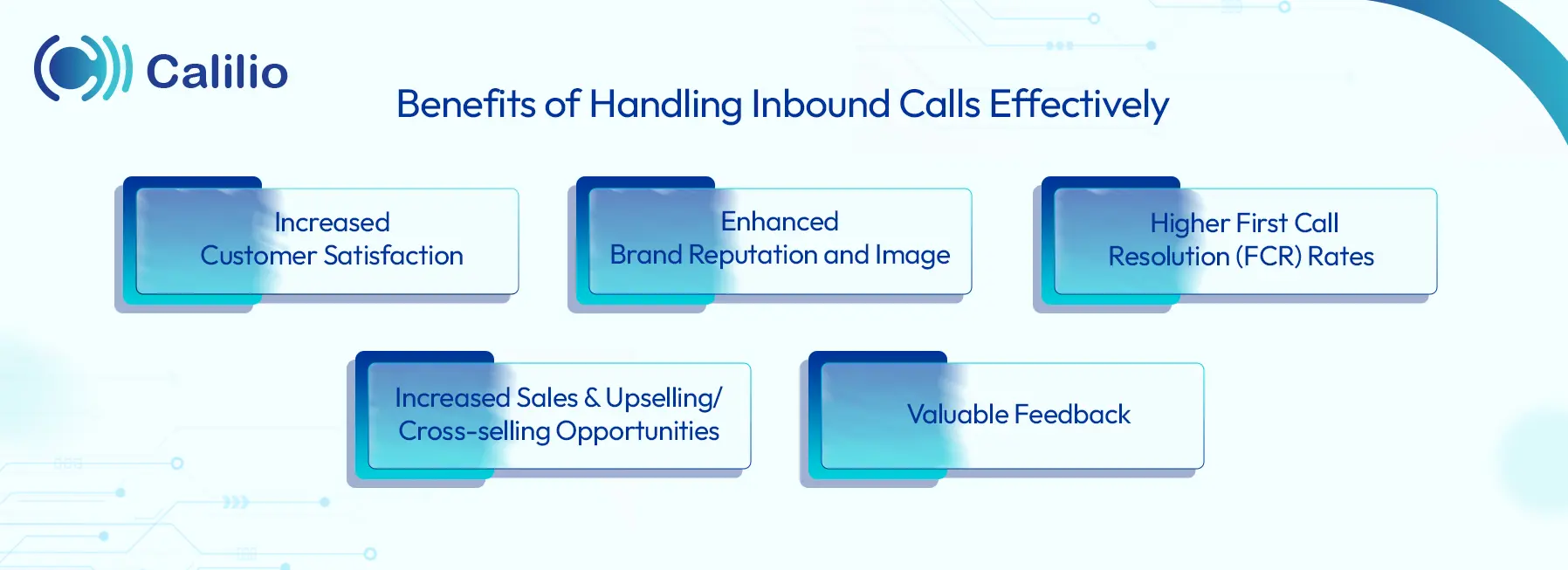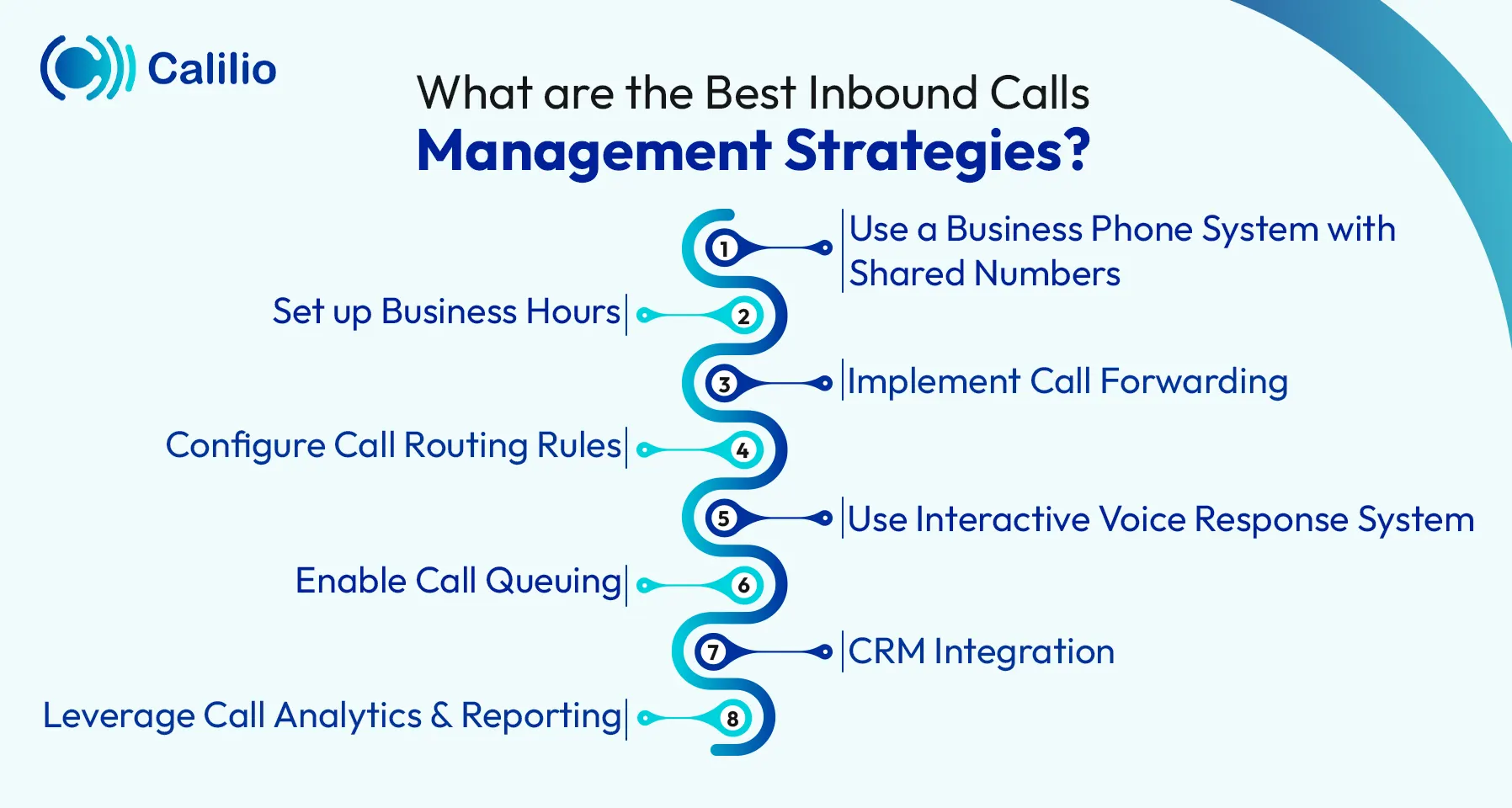Inbound Call Handling: How to Manage Customer Calls Effectively?

How you handle inbound calls in a business setting can make or break the customer experience. Whether you're missing calls, struggling with long hold times, or dealing with inconsistent responses from your team, poor inbound call handling can lead to frustrated customers and lost opportunities.
However, with the right approach and strategies, businesses can turn every inbound call into an opportunity to deliver exceptional services. This guide will walk you through the fundamentals of inbound call handling, why it matters, and proven ways to manage calls more efficiently.
Keep reading!
Key Highlights:
Inbound call handling refers to the process of managing incoming calls to a business, ensuring that customer inquiries are addressed.
Handling inbound calls properly boosts customer satisfaction, strengthens the brand reputation, increases first-call resolution rates, and provides valuable feedback for continuous improvement.
Inbound call management involves greeting callers professionally, listening with empathy, resolving issues clearly, escalating matters when necessary, and continually improving to ensure a consistently positive customer experience.
The best strategies for handling inbound calls involve using a phone system with shared numbers, IVR systems, call routing, CRM integration, and call analytics to ensure efficient, personalized, and seamless caller experiences.
What is Inbound Call Handling?
Inbound call handling refers to the process of managing and responding to incoming phone calls initiated by customers, clients, or prospects to a business. It involves answering calls efficiently, routing them to the appropriate department or agent, and resolving inquiries or issues in a timely and professional manner.
Benefits of Handling Inbound Calls Effectively
Managing inbound calls in the right way leads to increased customer satisfaction, a stronger brand reputation, and enhanced operational efficiency. It also opens opportunities for increased sales and provides valuable customer insights that drive continuous improvement.

1. Increased Customer Satisfaction
When calls are handled properly, customers feel heard, valued, and more likely to trust your business. When issues are resolved quickly and professionally, it boosts overall satisfaction and fosters long-term trust.
2. Enhanced Brand Reputation and Image
Consistent, high-quality phone interactions create a positive, customer-centric image of your brand. Satisfied callers are more likely to share positive experiences, improving your brand reputation both online and offline.
3. Higher First Call Resolution (FCR) Rates
When calls are routed correctly and handled by well-trained agents with access to the right tools and information, most issues can be resolved on the first call. This reduces the need for follow-ups, increasing productivity and enhancing first-call resolution rates.
4. Increased Sales and Upselling/Cross-selling Opportunities
Inbound calls come from potential buyers or existing customers seeking more information. Skilled agents can convert these interactions into sales or upsell/cross-sell opportunities, directly increasing revenue.
5. Valuable Feedback
Every inbound call is an opportunity to gather insights about customer expectations, pain points, and product/service issues. Analyzing this feedback enables you to pinpoint areas for improvement, address service gaps, and make informed, data-driven decisions to enhance products and services.
How to Handle Inbound Calls? Best Practices
Handling inbound calls involves greeting callers professionally, actively listening with empathy, and providing clear, efficient resolutions. By knowing when to escalate, closing calls positively, and continuously reflecting on performance, you can ensure a consistent and high-quality caller experience.
1. Start with a Professional and Friendly Greeting
Answer the call professionally by picking up within the first few rings and using a warm, clear, and polite tone. Mention your name, your position, and your company’s name to immediately establish credibility and confidence. A well-structured greeting sets a positive tone and reassures the caller that they’ve reached the right person.
2. Listen Actively and Show Empathy
Allow the caller to explain their concern without interruption. Practice active listening by taking notes, using verbal acknowledgments (such as “I understand” or “Absolutely”), and demonstrating genuine empathy.
3. Resolve Query Efficiently and Clearly
Once you understand the issue, respond with accurate and clear information. Avoid using complex jargon and focus on providing actionable solutions. If the issue requires a longer timeframe, communicate the process and expected timeframe honestly.
4. Transfer or Escalate When Needed
If the caller’s request is beyond your responsibility or expertise, transfer the call to the appropriate department or escalate it to a supervisor. Always explain why you're transferring the call and get permission before doing so. Provide relevant context to the next representative to avoid making the caller repeat themselves.
5. Summarize and Close on a Positive Note
Before ending the call, briefly summarize what was discussed and confirm that the caller’s issue is resolved. Offer to assist further and close with a friendly thank-you.
6. Reflect and Improve Continuously
After the call, take a moment to reflect on how it went. Identify what you did well and what could be improved. Utilize feedback and training materials to refine your communication and technical skills.
What are the Best Inbound Calls Management Strategies?
Effectively handling inbound calls requires a business phone system with shared numbers, IVR, call routing, and CRM integrations. You must also set up business hours, implement call forwarding, enable call queuing, and leverage call analytics.

1. Use a Business Phone System with Shared Numbers
Using a business phone system with a shared phone number is one of the most effective ways to handle inbound calls. It allows multiple team members to receive and respond to incoming calls from a single, centralized business number. This reduces the chances of missed calls when one agent is unavailable and provides a seamless customer experience.
Additionally, it also enables better team collaboration, transparency, and accountability, as call details can be tracked and managed within the central system.
2. Set up Business Hours
Setting business hours in your phone system ensures that incoming calls are handled appropriately according to the designated time. During business hours, calls can be directed to available agents or the team.
Moreover, after-hours calls can be handled through a voicemail with custom greetings. This offers an automated message and allows the caller to leave a message so that your team can follow up during the next business day.
3. Implement Call Forwarding
Implementing call forwarding is a powerful strategy for ensuring that inbound calls are never missed. It allows incoming calls to be automatically redirected to another number when the primary recipient is busy, unanswered, or unavailable. This ensures continuity of service, especially for remote teams, employees who frequently work outside the office, or during peak hours when the primary line may be busy.
4. Configure Call Routing Rules
Configuring call routing rules is essential for directing incoming calls to the most suitable agent or department based on specific criteria, such as caller input, time of day, or skill set. This makes sure that customers are quickly connected to the right person, thereby reducing wait times and enhancing the overall customer experience.
Common call routing types include skill-based routing, round-robin call routing, and priority routing, all of which aim to align customer needs with agent expertise.
5. Use Interactive Voice Response System
One of the best strategies for handling inbound calls efficiently is to implement an Interactive Voice Response (IVR) system. It lets callers easily navigate a menu with voice commands or keypad inputs, directing them to the most appropriate department without the need to speak with a live agent.
Additionally, self-service IVR enables callers to complete basic tasks, such as checking account balances, tracking orders, or getting business hours quickly and independently.
6. Enable Call Queuing
Call queuing is a reliable way to manage multiple incoming calls, especially during peak business hours. When all agents are busy, the system automatically places incoming callers in a virtual queue and holds their place in line until an agent becomes available.
Additionally, call queues can be customized with estimated wait times, on-hold music, and helpful messages to keep customers informed and engaged. Providing wait time estimates sets clear expectations, while on-hold music makes the wait more pleasant. Helpful messages, such as FAQs or service updates, keep customers informed and add value during their hold time, thereby improving the overall experience.
7. CRM Integration
Integrating your call system with CRM software allows agents to instantly access a customer’s profile, including their contact details, previous interactions, purchase history, and support tickets. This real-time visibility enables agents to deliver faster, more personalized service, as they no longer need to ask repetitive questions or manually search for information.
8. Leverage Call Analytics and Reporting
Tracking and analyzing call data is crucial for continually improving inbound call handling. It provides valuable insights into call volume, duration, wait times, agent performance, peak call hours, and customer satisfaction metrics. By analyzing this data, supervisors can identify trends, pinpoint inefficiencies, and make informed decisions to optimize workflows and resource allocation.
For example, if reports show long wait times during certain hours, you can adjust staffing accordingly. Additionally, call recordings and performance metrics help in coaching agents, enhancing quality assurance, and ensuring service standards are met.
Transform Your Inbound Call Handling with an Affordable Cloud Phone System!
Conclusion
Inbound call handling involves delivering a seamless, professional, and personalized experience that leaves a lasting impression on every caller. When handled well, it can improve customer satisfaction, enhance brand reputation, and drive business growth.
To achieve this level of efficiency and consistency, businesses require a reliable phone system that offers an advanced call management feature. Calilio is a cloud-based phone system that empowers businesses to handle inbound calls and outbound calls with greater efficiency and professionalism. With features like number sharing, your entire team can manage incoming calls collaboratively with the same business line.
Your Phone System Just Got Cheaper
Virtual numbers from just $2/month
Call rates starting as low as $0.016/min
The most cost-effective VoIP phone system for businesses
Powered by advanced AI telephony features
Compare low-cost business phone systems
Frequently Asked Questions
What are the common mistakes to avoid during inbound calls?
Common mistakes you must avoid during inbound calls include ignoring the caller’s tone or emotions, failing to follow up, and overwhelming them with excessive information.
What skills are essential for handling inbound calls?
What is the difference between inbound and outbound call handling?
What are the best phone systems for inbound call management?
How can I train agents to handle inbound calls more effectively?

Still have questions?
Can’t find the answer you’re looking for? Please chat with our friendly team.
Stay in the loop
Get the latest call insights, trends, and updates delivered straight to your inbox.
By subscribing, you agree to receive updates from Calilio.
You can unsubscribe anytime.
Phone numbers
Get International Phone Numbers
Singapore
|Australia
|New Zealand